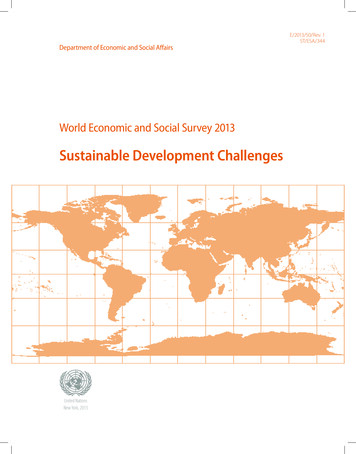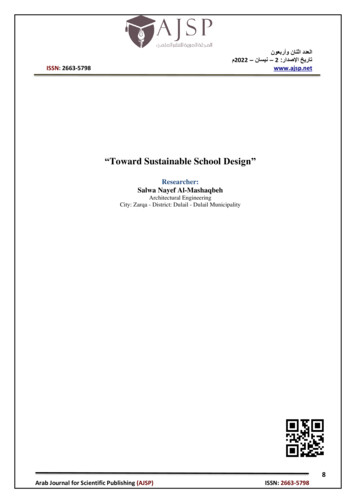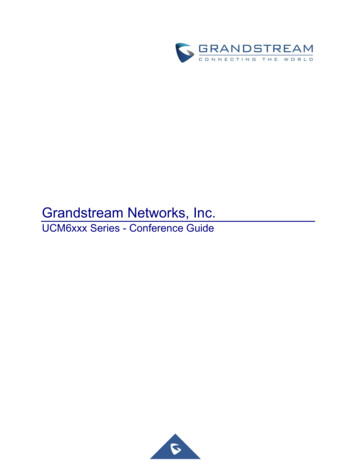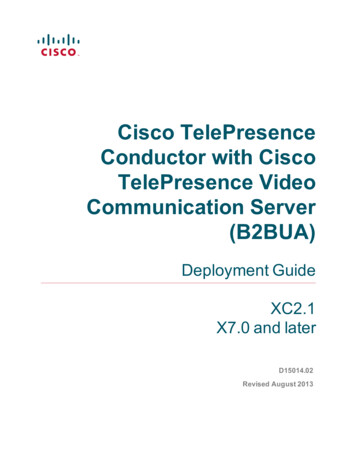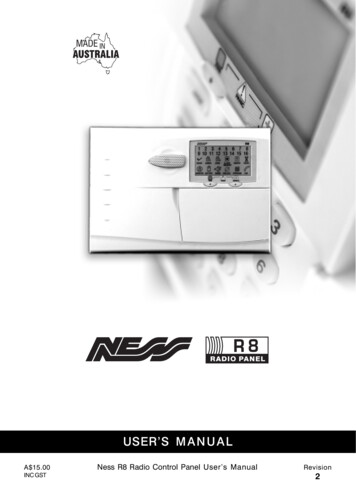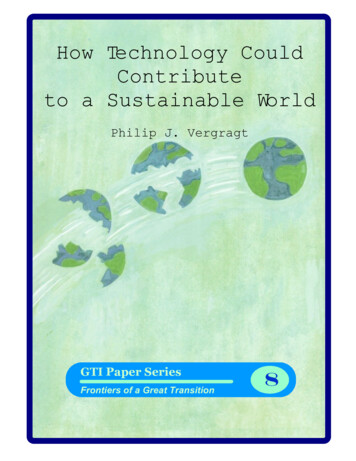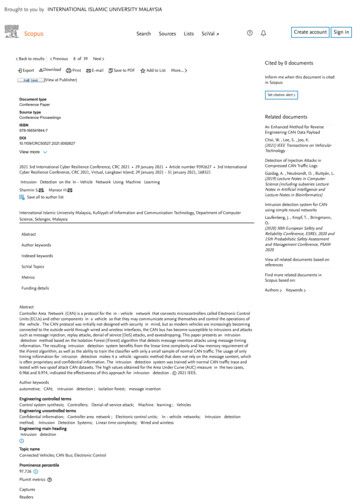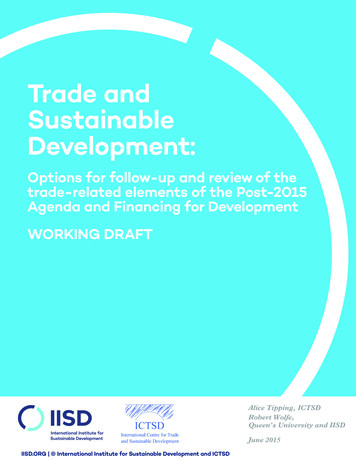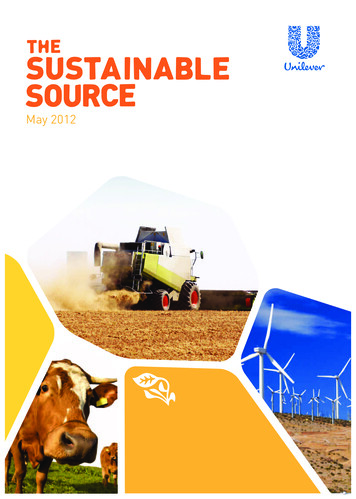
Transcription
International Conference on Sustainable Built EnvironmentsSpecial Session:Natural Systems to Control “Water Resources Pollution” and “WaterHazards”13th & 14th December, 2010University of PeradeniyaandEarl’s Regency Hotel, Kandy,Sri LankaSupported byAsia Africa Science Platform ProgramBy Japan Society for the Promotion of Science (JSPS)
December 2010 Copyright ReservedUniversity of Peradeniya, Saitama University, University of Moratuwa, University of Ruhuna and the organizingcommittee are not responsible for any errors of views expressed in the papers as these are the responsibility ofindividual authorsProceedings of the Special Session of the International Conference on:SUSTAINABLE BUILT ENVIRONEMENTSSupported by:Asia Africa Science Platform Program by Japan Society for the Promotion of Science (JSPS)
PROGRAMMEDateVenue13-DecemberExecutive Lounge @ Earl’s Regency Hotel, KandySession 1 – Chair- Dr. Gemunu Herath / Dr. Shoichiro Hamamoto13:30 Welcome Speech and Introduction for AA-CORE programDr. M.I.M. Mowjood/University of Peradeniya13:40 Guest SpeechProf. S.B. Weerakoon / Dean, Faculty of Engineering, University of Peradeniya13.50 Prof. Norio Tanaka / Saitama UniversityKey note SpeechTsunami force mitigation by tropical coastal trees, Pandanus odoratissimus and Casuarina equisetifolia,considering the effect of tree breaking14:10 Dr. Jagath Manatunge / University of MoratuwaSocioeconomic consequences due to alterations of coastal lagoon ecosystems14:25 Prof. Yasushi Sasaki / Saitama UniversityThe Role of human activities for the wetland ecosystem and water qualities, in case of Japanese wetland14.40 Dr. Tilak P. D. Gamage / University of RuhunaImpact of hydrological changes on the stability of coastal water-bodies and itsconsequences; a study based on four lagoons in southern Sri Lanka14.55 Dr. Junji Yagisawa / Saitama UniversityEffect of physical tree characteristic and substrate condition on maximum overturning moment15.10 Mr. Gayan Gunaratne / University of MoratuwaWater Balance and Renewal time of Rekawa Lagoon, Sri Lanka; A restorative approach.15:25-15:45 Tea BreakSession 2 - Chair Dr. Jagath Manatunge / Dr. Junji Yagisawa15:45 Invited PresentationMr. M.A.M.S.L. Attanayake / Deputy General Manager, National WaterSupply & Drainage Board16.00 Mr. Harsha Ratnasooriya / University of MoratuwaTsunami Hazards: Impact Mitigation Characteristics of Coastal Vegetation16:15 Dr. Shoichiro Hamamoto / Saitama UniversityEffects of Moisture Content and Shrinkage on Soil-Thermal Properties for Peat Soils in Japan16.30 Dr. S. K. Weragoda / National Water Supply and Drainage BoardApplication of Floating Wetlands at Tropical Context for Lake Water Reclamation16.45 Mrs. Ayomi WitharanaZinc Adsorption by Low-cost Sorbent materials: Clay tile, Brick, Sawdust and Rice husk17.00 Mr. Methsiri Samarakoon / Saitama UniversityEffectiveness of coastal forests in mitigating tsunami damage at eastern coast of Sri Lanka17:15 Mrs. G.M.P.R. Weerakoon / University of PeradeniyaPerformance evaluation of subsurface flow constructed wetland systems under variable hydraulicloading rates17:30 Mr. Yuta Yanase / Saitama UniversityConsolidation characteristics for Sri Lankan and Japanese clays: Void index in relation to stressstates and sedimentation environment17.45 Mr. Sisira Karunaratne / University of PeradeniyaAnalysis of drag force characteristics of real trees with three different types of vegetation for bioshield in coast18.00 Mr. I.S.K. Wijayawardane / University of MoratuwaCoastal Erosion: Investigations in the South - West Coast of Sri Lanka18.15 Closing Remarks Dr. Shameen Jinadasa1
PrefaceThe JSPS AA Science Platform Program is designed to create high potential research hubs in selectedfields within the Asian and African regions, while fostering the next generation of leading researchers.The three-year program proposed by Saitama University collaborating with three Sri Lankan universities(Univ. of Moratuwa, Univ. of Peradeniya and Univ. of Ruhuna) has been selected as one of the promisingdistinguished programs by the Japan Society for the Promotion of Science (JSPS). Exchanges will beconducted under the leadership of the core institution (Saitama University) and joint research, seminarsand other scientific meetings, and researcher exchanges will be organized and carried out effectivelyunder the program. It is also anticipated that the hubs formed by the core institutions will continue tocarry out important research activities after funding for the project has ended.I am very happy to hold the seminar of the program entitled ‘JSPS AA Science Platform Program ‘ withThe special session of International Conference on Sustainable Built Environments.I hope the seminar will provide an excellent opportunity to establish fruitful international collaborationbetween the above-mentioned universities.I would like to thank to Prof. S.B. Weerakoon, Prof. K.D.W. Nandalal, University of Peradeniya, Dr.Gemunu Herath, Dr. M.I.M. Mowjood and Dr. Shameen Jinadasa, coordinators from Univ. of Peradeniya,Dr. Jagath Manatunge, Sri Lankan Coordinator for the JSPS AA Science Platform Program fromUniversity of Moratuwa and Dr. Tilak Priyadarshana, Coordinator from University of Ruhuna, for theirefforts in organizing this seminar. I also thank Mr. M.A.M.S.L. Attanayake for delivering an invitedpresentation at this seminar. Finally, postgraduate student coordinators Mr.Sisira Karunarathne, GayanGunarathne and Mr. Methsiri Samrakoon have played a key role in planning of this special session atInternational Conference.Norio TanakaCoordinator of JSPS AA Science Platform Program on‘Development of bio-engineering by vegetation and for wetlands as a solution ofenvironmental and natural disaster problems for expanding urban fringe zone in Asia’Institute for Environmental Science and Technology,Graduate School of Science and Engineering,Professor at Saitama University,Japan2
Message from Co-ChairsProf. Ranjith DissanayakeUniversity of PeradeniyaProf. M. T. R JayasingheUniversity of MoratuwaProf. P. A. MendisUniversity of MelbourneThe building sector needs a new wave of innovation to drive dramatic reductions in environmental impactswhile sustaining economic growth and improving social outcomes.The International Conference on Sustainable Built Environment (ICSBE) –state of the art, brings togetheracademics, students, other researchers and practitioners from Sri Lanka and overseas to exchange ideas andexperiences on their recent research in all areas of sustainable built infrastructure. As awareness of climatechange, natural disasters, diminishing natural resources and energy costs increases, the demand for sustainabledesign and construction is increasing at an unprecedented rate. Participants will attend high qualitypresentations related to those areas by scientists representing both industry and academia.In addition there are special sessions on nanotechnology in construction organized by NANCO and the sessionon Natural Systems to Control “Water Resources Pollution” and “Water Hazards” Conducted by SaitamaUniversity, Japan. There is also the preconference International workshop on “Performance Based Review andDesign of Tall Buildings”. There are a number of world recognized experts presenting keynote speeches duringthe conference.This conference represents a unique opportunity for meeting colleagues and friends, exchanging ideas, andthose about research development work. The support of Institution of Engineers Sri Lanka (IE SL) is deeplyappreciated. We must also express our sincere thanks to all who contributed their time and great effort to makethe conference possible. Our special thanks go to the organizing committee. We would also like to thank all thereviewers of papers, whose reviews have been very important to maintain the quality of the conference.We are delighted that the Hon. Prime Minister, Mr. D.M. Jayaratne and Hon. Higher Education Minister, Mr. S. B.Dissanayake have accepted our invitation to open the conference.The Conference will deliver an awesome volume of information on sustainability initiatives in all building sectorsfrom around the globe, with up to 9 sessions from a diversity of focus groups and organisations presenting theirlatest findings. We would like to invite participants from all sectors, private and public, to join this important3
Message from the Dean, Faculty of Engineering,University of PeradeniyaI am pleased to send this message to the publication of the special session on ‘Naturalsystems to control water resources pollution and water hazards’ jointly organized bythe Civil Engineering Departments of Saitama University, University of Peradeniya,University of Moratuwa, University of Ruhuna at the International Conference onSustainable Built Environments.With the economic development and urbanization, increase of waste generationdemands sustainable means of pollution control to preserve water resources. On theother hand, the water related natural disasters caused by inland water have becomemore frequent, the damage in coastal regions by coastal storms and tsunamis areenormous. Therefore, the utilization of natural systems to protect the people,infrastructure and the environment by natural system itself needs to be investigatedand adopted as much as possible for eco-friendly development. I believe this specialsession would provide a forum to discuss and share the knowledge and finding basedon research and practice on this subject.I congratulate the organizers and contributors to this special session who madeanother activity under our existing collaboration with Saitama University a reality. Iwish the special session of the conference all the success and wish the collaborationamong our partner institutions grow further.Prof. S .B. Weerakoon,Professor in Civil EngineeringDean, Faculty of EngineeringUniversity of PeradeniyaPeradeniya,Sri Lanka4
Message from AA – CORE project coordinatorIt indeed gives me a great pleasure to send a message to the ICSBE Special Session tobe held at the Earl’s Regency Hotel, Kandy on 13th of December 2010. I am happy tonote that the ICSBE Special Session would be an important academic event of thepartner Universities. It is a very good opportunity for our academic staff andresearchers to present their research endeavors. Research, or the incessant search fornew knowledge, is an integral part not only of any university worthy of its name, butalso of all human enterprise.The academics circle engaged in this programme together with other staff are makingtheir name in many fields of knowledge and expertise. The ICSBE Special Sessionswill facilitate our academics, staff and students in developing and shaping theirresearch skills and capability.I am sure that the publication of the research papers presented at the ICSBE SpecialSession will be an incentive to our researchers for future endeavors in their researchareas of interest and expertise.Dr Tilak P. D. GamageDean, Faculty of Fisheries and Marine Sciences & Technology,University of Ruhuna,Matara,Sri Lanka5
Table of ContentProgramme1Preface2Prof. Norio TanakaMessage from Co – Chairs3Prof. P.B.R. Dissanayake, Prof. M.T.R. Jayasinghe, Prof. P.A. MendisMessage from the dean, faculty of engineering, University of Peradeniya4Prof. S .B. WeerakoonMessage from AA – CORE project coordinator5Dr. Tilak P. D. GamageTable of ContentsTsunami force mitigation by tropical coastal trees, Pandanus odoratissimus and Casuarinaequisetifolia, considering the effect of tree breaking - Norio Tanaka67 - 14The Role of human activities for the wetland ecosystem and water qualities, in case ofJapanese wetland - Yasushi Sasaki15 - 20Zinc Adsorption by Low-cost Sorbent materials: Clay tile, Brick, Sawdust and Rice huskAyomi Witharana21 - 28Effect of physical tree characteristic and substrate condition on maximum overturningmoment - Junji Yagisawa29 - 36Water Balance and Renewal time of Rekawa Lagoon, Sri Lanka; A restorative approach.Gayan Gunaratne37 - 44Tsunami Hazards: Impact Mitigation Characteristics of Coastal VegetationHarini Thalagala45 - 52Effects of Moisture Content and Shrinkage on Soil-Thermal Properties for Peat Soils in JapanShoichiro Hamamoto53 - 57Application of Floating Wetlands at Tropical Context for Lake Water ReclamationS.K. Weragoda58 - 64Effectiveness of coastal forests in mitigating tsunami damage at eastern coast of Sri LankaMethsiri Samarakoon65 - 72Performance evaluation of subsurface flow constructed wetland systems under variablehydraulic loading rates - G.M.P.R. Weerakoon73 - 81Consolidation characteristics for Sri Lankan and Japanese clays: Void index in relation tostress states and sedimentation environment - Yuta Yanase82 - 88Analysis of drag force characteristics of real trees with three different types of vegetation forbio-shield in coast - Sisira Karunaratne89 - 95Coastal Erosion: Investigations in the south - west Coast of Sri LankaI.S.K. Wijayawardane96 - 1026
TSUNAMI FORCE MITIGATION BY TROPICAL COASTAL TREES,PANDANUS ODORATISSIMUS AND CASUARINA EQUISETIFOLIA,CONSIDERING THE EFFECT OF TREE BREAKINGNorio Tanaka 1, 2, Nguyen Ba Thuy 31Professor, Institute for Environmental Science and Technology, Saitama University2Professor, Graduate School of Science and Engineering, Saitama University1,2E-mail: tanaka01@mail.saitama-u.ac.jp1,2Telephone: 81 48 858 3564; Fax: 81 48 858 35643Researcher, Marine Hydrometeorological Center, Vietnam.2E-mail: thuybanguyen@yahoo.comAbstract: A numerical model based on two-dimensional nonlinear long-wave equations that include drag forcesand turbulence induced shear force due to the presence of vegetation was developed for estimating tree breaking.The numerical model was then applied to a coastal forest, where two dominant tropical vegetation tree specieswere considered, Pandanus odoratissimus and Casuarina equisetifolia. Quantitative effects of the coastal forestdestruction by tsunami on the decrement of tsunami force behind the forest were evaluated with or withoutincluding the destruction mode into the model. The analysis satisfies the previous field investigation knowledgethat the critical breaking tsunami water depth is around 80% of the tree height when tree height is larger than 2mfor P. odoratissimus. P. odoratissimus can reduce tsunami force higher than C. equisetifolia due to the complex ofaerial root structures. Even when the trees are destructed at just above the aerial roots, tsunami force reductionrate are decreased by 20%, 10% for 2-4m trees, 6-8 m trees, respectively, because of the existence of dense aerialroots in case of a P. odoratissimus. The previous numerical models that do not include the breaking phenomenahave a possibility to overestimate the vegetation effect for reducing tsunami force. The reduction of tsunamimitigation effect by breaking is larger for C. equisetifolia, however their growth rate is larger than P.odoratissimus and is hardly broken. The combination of P. odoratissimus and C. equisetifolia was recommendedas a vegetation bioshield to protect coastal area from tsunami hazards.Keywords: Vegetation bioshield, Trunk breakage, Pandanus odoratissimus, Casuarina equisetifolia, Tsunamiforce and moment acting on tree trunk1IntroductionCoastal vegetation has been found to play a significant role in reducing the tsunami energy and damageto humans and properties (Shuto, 1987; Danielsen et al. 2005; Tanaka et al., 2007), although their role isstill questioned due to the absence of adequate studies (Kerr and Baird, 2007). Based on the fieldinvestigations carried out in Sri Lanka and Thailand after the Indian Ocean tsunami and in Indonesiaafter the Java tsunami on 2006, Tanaka et al. (2007) pointed out that Pandanus odoratissimus grown onbeach sand is especially effective in providing protection from tsunami damage due to its density andcomplex aerial root structure, but it is not strong enough to withstand more than 5m-tsunami. Thetsunami water depth for bending or breaking P. odoratissimus was observed above 80% of the treeheight (Tanaka and Sasaki, 2007). On the other hand, Casuarina equisetifolia, one of the otherdominant vegetation was found to be effective in providing protection from tsunami due to its higherdensity, especially they are young. C. equisetifolia does not have aerial roots and its trunks were rarelybroken, however, young C. equisetifolia (less than 10cm-trunk diameter) were broken at the IndianOcean tsunami (Tanaka et al., 2007, 2009). Observation reported that most of the damage to C.equisetifolia of which trunk diameter is larger than 15 cm was uprooting by scouring around roots.However, the uprooting was limited at the front region of forest against tsunami.Some previous studies have discussed the effects of vegetation on tsunami mitigation based on thenumerical simulation results (Nandasena et al. 2008, Tanaka et al. 2009, Thuy et al. 2009a and b, Thuyet al. 2010). However, the effect of tree breakage was not considered, because the tsunami water depthInternational Conference on Sustainable Built Environment (ICSBE-2010)Kandy, 13-14 December 20107
in their simulation range was less than 80% of the tree height.Therefore the objective of this study is to know quantitatively how the breaking of trees in a forestaffects on the tsunami disaster mitigation effects. In the present paper, a coastal forest of P.odoratissimus or C. equisetifolia was considered and potential tsunami force and bending moments on atree were studied by numerical simulations. The numerical model is based on two-dimensionalnonlinear long-wave equations as the same in Thuy et al. (2009a) which was developed for includingtree breaking effect. The numerical results are validated with field measurement data of the thresholdwater depth for tree breaking, and then breaking length, reduction of water depth and potential tsunamiforce are discussed with the tree growth stage.2Mathematical model and calculation procedure2.1 Governing equationsThe governing equations are two-dimensional nonlinear long-wave equations that include drag andeddy viscosity forces due to interaction with vegetation. The continuity and the momentum equationsare respectively: (dVx ) (dVy ) 0 t x y Vx V V bxFE Vx x Vy x g x Vx 0 x d d t x yd Vy t Vx Vy x Vy Vywhere, b F y g gn 2d1/ 3 by Fy EVy 0d y d d VV 1 CD all bref V V d2(1)(2)(3)(4)(5)Evx 2 Vy V V d e x d e x d e x y x x y (6)Evy 2 V V V d e y d e x d e y x y y y x (7)x and y are the horizontal coordinates; Vx and Vy are the depth-averaged velocity components in x and ydirections respectively; t is the time; d the total water depth (d h ); h the local still water depth (onland, the negative height of the ground surface); the water surface elevation; g the gravitationalacceleration; the water density; n the Manning roughness coefficient ( 0.025 in this tudy); the treedensity (number of trees/m2). CD-all is the depth-averaged equivalent drag coefficient considering thevertical stand structure of the trees, which was defined by Tanaka et al. (2007) as:C D all (d ) C D ref1 d b( z G ) C D ( z G )1 d)dz G C D ref ( z G ) ( z G )dz G 0dbref C Drefd 0(8)where b(zG) and CD(zG) are the projected width and drag coefficient of a tree at the height zG from theground surface, and bref and CD-ref are the reference projected width and reference drag coefficient of thetrunk at zG 1.2 m in principle, respectively. The eddy viscosity coefficient ve is expressed in the SDSturbulence model (Nadaoka and Yagi 1998, Thuy et al. 2009a). For details of (zG), (zG), and CD-all ofP. odoratissimus and C. equisetifolia, see Tanaka et al. (2007) and Thuy et al.(2010).International Conference on Sustainable Built Environment (ICSBE-2010)Kandy, 13-14 December 20108
2.2 Definitions of tsunami force and bending moment on a tree The tsunami force vector ( F * ) in the present study is defined by the following equation: 1 (9)F * dV V2This is the potential tsunami force integrated over the inundation depth and corresponds to the total dragforce due to the tsunami acting on a virtual tall column of unit width and a unit drag coefficient (Thuy etal., 2010). On the other hand, the tsunami bending moment vector ( M Tree ) at a critical height (hc) of the tree fromthe ground surface is expressed as follows: d1M Tree C Dref bref V V ( zG hc ) dzG , hc d H Treehc2 0,d hc(10)where hc is critical height (top of aerial of for P. odoratissimus, 0 for C. equisetifolia). The notation of M Tree is replaced by M P and M hereafter for P. odoratissimus and C. equisetifolia.CTanaka et al. (2009) proposed an empirical formula to calculate the breaking moment (unit: Nm) MBPand MCP of P. odoratissimus and C. equisetifolia. The equation converted into SI unit is as follows:MBP 4.45 (100bref)2.62for P. odoratissimusMBC 4.90 (1.5 x 100bref)3for C. equisetifolia(11)where the empirical constants 4.45 and 4.90 have a dimension.2.3 Method of numerical simulations, Coastal topography and forest conditionsA set of the above equations is solved by the finite-difference method of a staggered leap-frog schemewhich is widely used in numerical simulations of tsunami. The numerical scheme is described in detailin Thuy et al. (2009a). A sinusoidal incident tsunami was given as a time-dependent boundary conditionat the most offshore side of the wave-generation zone. In the numerical simulation, the uniform grid sizeof 2.5 m was applied.A uniform coastal topography with the cross-shore section perpendicular (x-axis) to a straight shoreline,as shown in Figure 1(a), was selected as a model case. The bed profile of the domain consists of fourslopes, S 1/10, 1/100, 1/50, and 1/500. The offshore water depth at an additional wave-generation zonewith a horizontal bottom is 100 m below the datum level of z 0. The tide level at the attack of thetsunami was considered to be 2 m, and therefore the still water level is 2 m above the datum level. Thedirection of the incident tsunami is perpendicular to the shoreline. In the present paper, the run-up of thefirst wave only is discussed. The coastal forest starts at the starting point of the 1/500 slope on the land(x 5700 m), where the ground is 4 m above the datum level (2 m above the tide level at the tsunamievent). The forest was assumed to extend finite in the direction of the shoreline (y-axis). The value ofCD-all varied with the total depth d (inundation depth) because the projected width b and the dragcoefficient CD vary with the height from the ground surface zG. Figure 1 (b) shows the variation of CD-allof P. odoratissimus by water depth with tree growth stage (2, 4, 6 and 8 m tree height).3Results and discussion3.1 Tsunami bending moment on a tree –Breaking of P. odoratissimusFigure 2(a) and (b) shows the comparison of time profile of water depth and velocity in front and behindthe forest for two models: N.B.M. and B.M. The velocity and water depth behind the forest is increasedafter tree breaking owing to the reduction in drag resistance. However, in front of vegetation, the waterdepth decreases while the velocity increases due to the reduction of the reflection from vegetation.International Conference on Sustainable Built Environment (ICSBE-2010)Kandy, 13-14 December 20109
z (m)Tsunami water depth (m)Vegetation1150050200-2000-20020004000600010000x (m)1100-408000-60-8010- 2mHtreeHtree-2mHtree- 4mHtree-4mHtree- 6mHtree-6mHtree - 8m86Htree-8m4201100246-100810C D-all(a)(b)Figure 1: Condition of numerical simulation, (a) schematic of topography for numerical simulation, (b) variationof CD-all with water depth for four cases of P. odoratissimus height854d (m), V (m/s)d (m), V (m/s)6Water depth-N.B.M.Water depth-B.M.Velocity-N.B.M.Velocity-B.M.5Water depth-N.B.M.Water 500600700800t (s)90010001100-150060070080090010001100t (s)(a)(b)Figure 2: Time profile of water depth and velocity. (a) at front of forest, (b) at behind the coastal forestFigure 3 shows spatial distribution of the maximum tsunami moments along the forest for two models.According to the result, the damage length of forest by B.M. is about 77.5 m (77.5%), and increased incomparison with N.B.M. due to the decrease in vegetation resistance in the front area where vegetationwas broken.Figure 4 shows the relationship between the reduction rate of water depth (dmax/dmax0), tsunami force(F*max/F*max0) and survival rate of P. odoratissimus (number of unbroken trees /total tree) and incidenttsunami water depth, where subscript 0 indicates the case of no forest. The results show that trees startbreaking at HF0 4.8 m. When HF0 reaches to 5.5 m, all the trees are broken. The reduction of water depthand tsunami force is about 25 and 54 % respectively, and it decreases when the incident tsunami waterdepth exceeds the initial breaking of water depth (I.B. in the figure).M P max (N.B.M.)7M BPMP max (kNm)6543Breaking length (N.B.M.)M P max(B.M.)21Breaking length (B.M.)05700Front edge57205740x (m)576057805800Rear edgeFigure 3: Damage length simulated by two numerical modelsInternational Conference on Sustainable Built Environment (ICSBE-2010)Kandy, 13-14 December 201010
10.80.80.60.6 Water depth Tsunami force Survival rate0.40.20.4Survival rated max/d max0, F* max/F* max010.2I.B0033.544.555.566.57H F 0 (m)Figure 4: Relationship between incident tsunami water depth (at the front of forest) and reduction rate ofwater depth (dmax/dmax1), tsunami force (F*max/F*max1) and survival rate (number of unbroken trees /total tree)of P. odoratissimus, where subscript 0 indicates the case of no vegetation3.2 Damage of P. odoratissimus by tsunami with tree growth stage - Validation the numerical resultswith field measurement dataThe threshold water depths for tree breaking obtained from field measurement in Sri Lanka andThailand after Indian Ocean tsunami in 2004 and Indonesia in Java tsunami 2006 were used to validatethe numerical model. Breaking of vegetation depends on the tsunami height and the tree height. Figure5(a) shows the observation of tree conditions (broken or not) against tsunami water depth for differenttree height. As already discussed by Tanaka et al. (2009), most of the tree was broken when the tsunamiwater depth exceeds 80% of tree height. To validate the numerical model for the observed thresholdvalues of water depth for tree breaking with tree growth stage, the critical height for tree height of 2, 4,6, 8 m were selected as 0.5, 1, 2, 2 m respectively, and corresponding the reference diameters are 0.1,0.124, 0.155 and 0.195 m respectively based on the field observation. The breaking moment for treeheight of 2, 4, 6 and 8 m are 10.7, 5.85, 3.25 and 1.85 kNm, respectively. Figure 5(b) shows thenumerical result of the threshold water depth (including the increase of water surface elevation due toreflection by the vegetation) of tree breaking for different tree height with different forest width. Theline represents the height of 80% of tree height. This is the minimum height of water depth for treebreaking (Tanaka et al. 2009). The threshold water depth is simulated around the observed breaking line,and it increases with increasing in forest width, mainly due to the decrease of velocity.The reduction of tsunami energy behind a coastal forest depends on the height of tree due to the effect ofvertical configuration and tree diameter. CD-all depends on the height of tree and vertical configuration.Figure 6 shows the reduction rate of tsunami force against incident tsunami water depth, where theforest width was selected of 100 m and tree density of 0.2 trees/m2 for each tree height case. The initialincident tsunami water depth for tree breaking for the tree height of 2, 4, 6 and 8 m are of 3.9, 4.2, 4.8and 5.3 m respectively. The taller tree can be reduced higher tsunami energy than the shorter tree. Foreach tree height case the reduction rate of tsunami force increases as the incident tsunami water depths ishigher than the I.B. values. However, for tree height of 2 and 4 m, the reduction rate of tsunami forceincreases suddenly, and become almost constant as the incident tsunami water depth increases. This isdue to all trees can be broken when water depth is larger that the threshold value and the drag resistanceby the remaining short aerial root is smaller than the case of 6 and 8 m-trees.3.3 Breaking of C. equisetifolia and effect of two layers vegetationIn this section, the effect of young C. equisetifolia trees on tsunami reduction was discussed withconsidering the bending effect. C. equisetifolia. Observation in Laem Son National park in Thailand(Tanaka et al., 2007) showed that only young C. equisetifolia with the trunk diameter about 0.07 m wasbending and inclined under the tsunami height of 5 m. The angle between the trunk and ground wasInternational Conference on Sustainable Built Environment (ICSBE-2010)Kandy, 13-14 December 201011
observed as 15-45º. The bending tree as well as the inclined angle of trunk would make a role on thereduction of tsunami energy, and therefore the bending effect of C. equisetifolia should be discussed.For the cylinder inclined to the flow direction, the drag coefficient may change. The present study useda simple recommendation formula from Post-Tensioning Institute PTI (Poulin and Larsen 2007) on therelation of drag coefficient against the inclined angle as:CD CD0 sin3 (12)Where, CD0 is the drag coefficient for the case the flow has direction perpendicular to the trunk,corresponding to V0 (velocity component perpendicular to the trunk). The project width of vegetationwas also changed and depends on the inclined angle.Figure 7 shows the reduction rate of tsunami force with incident tsunami water depth for three cases oftree growth stage corresponding to trunk di
the Civil Engineering Departments of Saitama University, University of Peradeniya, University of Moratuwa, University of Ruhuna at the International Conference on Sustainable Built Environments. With the economic development and urbanization, increase of waste generation demands sustainable means of pollution control to preserve water resources.
